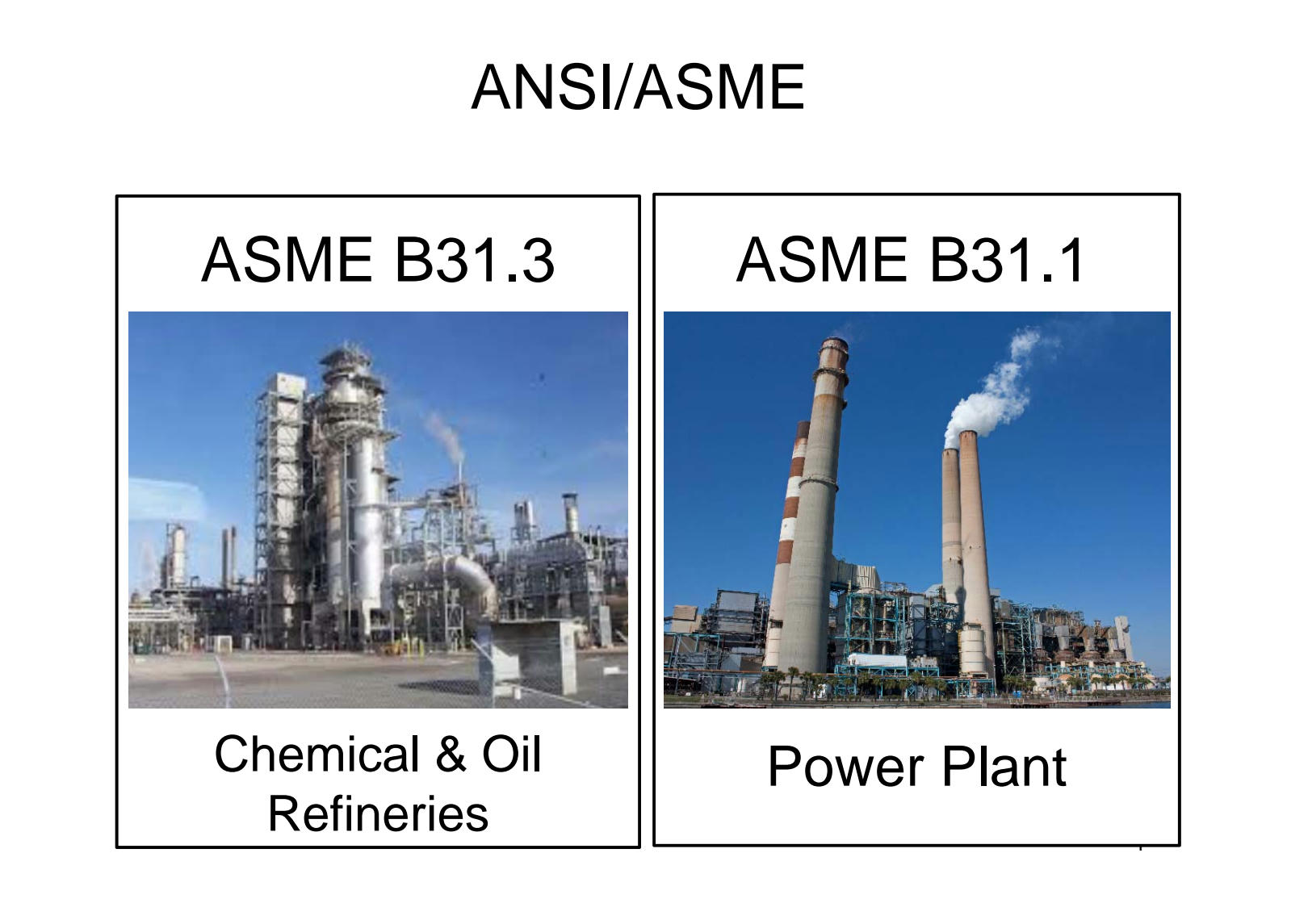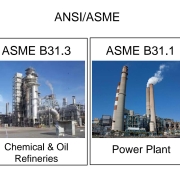ASME B31.1 vs. ASME B31.3: Know the Piping Design Codes
Introduction
In piping design and engineering, selecting the appropriate piping code is essential for ensuring safety, efficiency, and compliance with industry standards. Two of the most widely recognized piping design codes are ASME B31.1 and ASME B31.3. While they both come from the American Society of Mechanical Engineers (ASME) and govern the design and construction of piping systems, their applications differ significantly. Understanding the ASME B31.1 vs. ASME B31.3 debate is crucial for selecting the correct code for your project, whether it involves power plants, chemical processing, or industrial facilities.
Overview: ASME B31.1 vs. ASME B31.3
What is ASME B31.3 or Process Piping Code?
ASME B31.1 is the standard that governs the design, construction, and maintenance of power plant piping systems. It applies to piping systems in power plants, industrial plants, and other facilities where power generation is involved. This code focuses heavily on the integrity of systems that handle high-pressure steam, water, and hot gases.
Typical Applications: Power plants, heating systems, turbines, and boiler systems.
Pressure Range: High-pressure steam and fluid systems.
Temperature Range: High-temperature service, especially for steam and gas applications.
What is ASME B31.1 or Power Piping Code?
ASME B31.3 applies to the design and construction of piping systems used in chemical, petrochemical, and pharmaceutical industries. It governs systems that transport chemicals, gases, or liquids under different pressure and temperature conditions, often including hazardous materials. This code also covers the associated support systems and the safety considerations of handling chemicals and dangerous substances.
Typical Applications: Chemical processing plants, refineries, pharmaceutical facilities, food and beverage plants.
Pressure Range: Generally lower than the pressure range in ASME B31.1, depending on fluid types and their classification.
Temperature Range: varies depending on the chemical fluids, but it is typically lower than the extreme conditions in ASME B31.1.
Difference Between ASME B31.3 and ASME B31.1 (ASME B31.3 vs ASME B31.1)

ASME B31.3 vs ASME B31.1
| Sr No | Parameter | ASME B31.3-Process Piping | ASME B31.1-Power Piping |
| 1 | Scope | Provides rules for Process or Chemical Plants | Provides rules for Power Plants |
| 2 | Basic Allowable Material Stress | Basic allowable material stress value is higher (For example the allowable stress value for A 106 B material at 250 Deg C is 132117.328 Kpa as per ASME B31.3) | Basic allowable material stress value is lower (For example the allowable stress value for A 106 B material at 250 Deg C is 117900.344 Kpa as per ASME B31.3) |
| 3 | Allowable Sagging (Sustained) | The ASME B31.3 code does not specifically limit allowable sagging. An allowable sagging of up to 15 mm is generally acceptable. ASME B31.3 does not provide a suggested support span. | ASME B31.1 clearly specifies the allowable sagging value as 2.5 mm. Table 121.5-1 of ASME B31.1 provides suggested support span. |
| 4 | SIF on Reducers | Process Piping Code ASME B31.3 does not use SIF (SIF=1.0) for reducer stress calculation | Power Piping code ASME B31.1 uses a maximum SIF of 2.0 for reducers while stress calculation. |
| 5 | Factor of Safety | ASME B31.3 uses a factor of safety of 3; relatively lower than ASME B31.1. | ASME B31.1 uses a safety factor of 4 to have higher reliability as compared to Process plants |
| 6 | SIF for Butt Welded Joints | ASME B31.3 uses a SIF of 1.0 for buttwelded joints | ASME B31.1 uses a SIF of up to 1.9 max in stress calculation. |
| 7 | Approach towards SIF | ASME B31.3 uses a complex in-plane, out-of-plane SIF approach. | ASME B31.1 uses a simplified single SIF Approach. |
| 8 | Maximum values of Sc and Sh | As per the Process Piping code, the maximum value of Sc and Sh are limited to 138 Mpa or 20 ksi. | For the Power piping code, the maximum value of Sc and Sh are 138 Mpa only if the minimum tensile strength of the material is 70 ksi (480Mpa); otherwise, it depends on the values provided in the mandatory appendix A as per temperature. |
| 9 | Allowable Stress for Occasional Stresses | The allowable value of occasional stress is 1.33 times Sh | As per ASME B31.1, the allowable value of occasional stress is 1.15 to 1.20 times Sh |
| 10 | The equation for Pipe Wall Thickness Calculation | The equation for pipe wall thickness calculation is valid for t<D/6 | There is no such limitation in the Power piping wall thickness calculation. However, they add a limitation on maximum design pressure. |
| 11 | Section Modulus, Z for Sustained and Occasional Stresses | While Sustained and Occasional stress calculation the Process Piping code reduces the thickness by corrosion and other allowances. | ASME B31.1 calculates the section modulus using nominal thickness. Thickness is not reduced by corrosion and other allowances. |
| 12 | Rules for material usage below -29 Deg. C | ASME B31.3 provides extensive rules for the use of materials below -29 degrees C | The power piping code provides no such rules for pipe materials below -29 degrees C. |
| 13 | Maximum Value of Cyclic Stress Range Factor | The maximum value of cyclic stress range factor f is 1.2 | The maximum value of is 1.0 |
| 14 | Allowance for Pressure Temperature Variation | As per clause 302.2.4 of ASME B31.3, occasional pressure temperature variation can exceed the allowable by (a) 33% for no more than 10 hours at any one time and no more than 100 hours/year, or (b) 20% for no more than 50 hours at any one time and no more than 500 hours/year. | As per clause 102.2.4 of ASME B31.1, occasional pressure temperature variation can exceed the allowable by (a) 15% if the event duration occurs for no more than 8 hours at any one time and not more than 800 hours/year or (b) 20% if the event duration occurs for not more than 1 hour at any one time and not more than 80 hour/year. |
| 15 | Design Life | Process Piping is normally designed for 20 to 30 years of service life. | Power Piping is generally designed for 40 years or more of service life. |
| 16 | PSV reaction force | ASME B31.3 does not provide specific equations for PSV reaction force calculation. | ASME B31.1 provides specific equations for PSV reaction force calculation. |
Conclusion
The critical difference in the ASME B31.1 vs. ASME B31.3 debate lies in the industry applications, material requirements, and safety considerations. ASME B31.1 is ideal for power generation and high-temperature systems, focusing on mechanical integrity. At the same time, ASME B31.3 is tailored for the chemical and process industries, emphasizing the safe handling of hazardous materials and chemical compatibility. By understanding the distinctions between these two standards, you can decide which code best suits your project’s requirements, ensuring compliance and safety throughout the project’s lifecycle. Whether you are involved in power plant design or system’ processing, choosing the correct piping code is crucial for a successful project.


